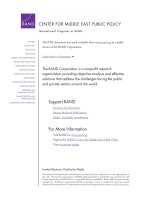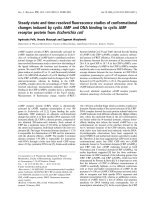Ch03 state and local governments overview and CAFR
Bạn đang xem bản rút gọn của tài liệu. Xem và tải ngay bản đầy đủ của tài liệu tại đây (93.57 KB, 47 trang )
CHAPTER 3
State And Local Governments:
Overview, Comprehensive Annual
Financial Reports And Governmentwide Statements
Learning Objectives
• Able to
– Identify various aspects of state and local
governments including
• Characteristics and nature
• Financial reporting objectives
• Financial reporting standards
– Familiar with management discussion and
analysis reporting requirement
Learning Objectives [cont’d]
• Know the government-wide financial
statement components
– Statement of net assets
– Statement of activities
• Understand the display used in governmentwide financial statements
Nature of Governments
• Government entities are not just federal
government
• Extensive number of state and local
governments
• These entities are governed by
GAAP(generally accepted accounting
principals) which are set GASP
Levels of Government GAAP
Level A
GASB Statements, AICPA pronouncements
made specifically by GASB
Level B
GASB technical bulletins and AICPA industry and
accounting guides and Statements of Position if
made specifically applicable and cleared by
GASB
Level C
AICPA practice bulletins cleared by GASB and
EITF consensus positions, if GASB creates such
a group
Level D
GASB implementation guides and industry
practice that are widely recognized and prevalent
Government GAAP
• Requires the display of two distinct financial
statements
– Government-wide financial statements
• Uses full accrual accounting recognition
– Fund based financial statements
• Uses both modified and full accrual accounting
recognition
Financial Report Enables User to:
• Asses the finances of the government including
the current year’s operation
• Determine whether the government’s overall
financial position is improving or not.
• Evaluate whether the government’s current year
revenues were sufficient to pay for all the
current year’s services.
• Identify the government’s cost of providing
services to its citizens
Users Abilities (cont’d)
• Determine how the government finances its
programs such as program revenues, user
fees or tax revenues.
• View the extent to which the government has
invested resources in capital assets.
• Provide the ability to compare financial data
between governments
Characteristics of Government
Entities
•
•
•
•
Organized to serve citizens in their jurisdiction
Principal source of revenue is taxes
A profit motive is rare
Each entity has an accountability and
stewardship for resources entrusted to
government
• Measuring quality or quantity of services
provided can be difficult
Characteristics of Government Entities
[cont’d]
• A government organization has one or more
of the following
– Officers elected by popular election
– Possible dissolution of organization with net
assets reverting to a government
– Organization has power to enact and enforce tax
levy
– Organization has authority to issue tax-exempt
debt
Who uses Government Financial
Statement
Financial Reporting provides information that
facilitates decision making by user groups
– Citizens of government entity
– Direct representatives of citizens
– Investors, creditors, and others in lending
process
Financial Reporting Objectives
• Accountability is paramount
– Based on transfer of responsibility for resources
or actions from citizens to some other party
• Accountability fulfilled
– Financial statement display the management of
the government
– Enable data users to determine interperiod
equity
Financial Reporting Entity
• Primary Government
– State or Local general-purpose government
• Component Units
– Legally separate organizations which
• Elected officials of primary government are
financially accountable
• Financial accountability exists
• May impose a financial burden or provide a
financial benefit
Methods for Including Components in
Financial Information
• Blending
– Adding of assets, liabilities, etc. to the primary
government financial statements
• Discrete Presentation
– Presents the financial information of the
component units in a separate discrete column on
the primary government financial statements
Governmental Financial Plan
• Financial plan of government is a budget
– Provides means of control
– Expresses public policy and financial intent of
government entity
– Enacted budgets usually considered law
– Generally must be balanced
Governmental Financial Budgets
• Criteria provided by GASB governmental
budgets includes:
– Annual budgets should be adopted by every
government entity
– Accounting system should provide basis for
appropriate budgetary control
– Common terminology and classification should
be used consistently throughout budget,
accounts, and financial reports
Governmental Budgets
• Major types
– Annual operating budget
• Estimated revenues and appropriations for a
specific fiscal period
• Provides device for management and control
– Capital budget
• Control the expenditures for construction
projects, plant, and fixed asset acquisitions
• Other types include budgets to track objects,
programs or performance
Financial Reporting Uses
• Financial reports provide data for comparing
legally adopted budgets with actual results.
• Financial reports are essential for
demonstrating compliance with legally
mandated activities
Financial Reporting Uses [cont’d]
• Displays performance effectiveness or
efficiency
• Provides the level of service efforts
– Inputs
– Outputs
– Outcomes
Revenue Recognition
• The GASB classified nonexchange
transactions into four classifications
– Derived tax revenues
– Imposed nonexchange revenues
– Government-mandated nonexchange
transactions
– Voluntary nonexchange transactions
Derived Tax Revenues
• Assessments imposed by governments on
exchange transactions
• Typically are taxes that are charged when an
event occurs
• Examples include – personal income tax,
corporate or franchise taxes and sales taxes
Imposed Nonexchange Revenues
• Assessments by the government on
nongovernmental entities
• Typically are levied taxes
• Examples include property taxes, fines,
penalties and property forfeitures
Government-mandated Nonexchange
Revenues
• A government provides resources to another government
and requires that the recipient government use the
resources for a specific use
– Typically this is resources provided by the federal government to
state government or state government to city or county
governments
• An example is the federal government providing the state
government resources to train rural fire fighters
• Another example is the state government providing the city
government resources for social work or criminal justice
programs.
Voluntary Nonexchange Revenues
• Transfer of resources from one party to
another without any expectation of receiving
anything of equal value in return.
– Can be based on on either written or oral
agreement
• Examples include gifts, grants and donations
• Recognized only if recipient is eligible to use
resources
Eligibility Recognition Requirements
• No recognition if not met
– Recipient has characteristics set forth by the
provider
– Time requirements [advance payments are
recognized as deferred revenue]
– Allowable costs have been incurred for which
the provider will reimbursement
– Contingencies outlined by the provider have
been achieved









